The Early Stone Age : Physical types associated with it.
Early Stone Age : Physical types associated with it.
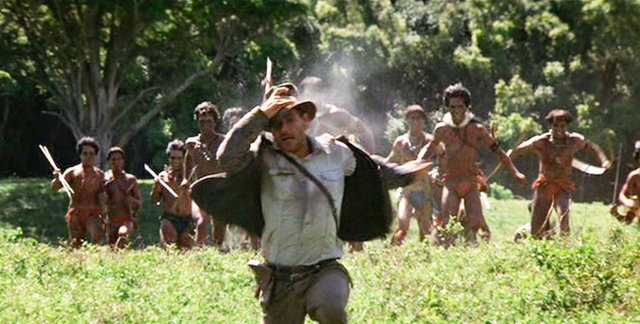
The Australopithecinae
Three super families are used to classify the living anthropoid primates:
1. The New World monkeys (the Ceboidea)
2. The Old World monkeys (the Cercopithecoidea)
3. The apes and humans (the Hominoidea)

Humans are the only living representatives of the of the family Hominidae (genus Homo (true humans), species sapiens sapiens (wise wise man). The last common ancestor (LCA) of the gorillas, chimpanzees and humans existed during the late Miocene (10-5.2 mya)in Africa. Habitats have changed since the Miocene and the large-bodied hominoids gradually adapted to ground-living in more open environments. Approximately 6 million years ago the spilt between chimpanzee and human lineages coincided with global climatic change.
The australopithecines are a group of extinct hominins of which fossil remains date to the later Pliocene and the early Pliestocene. The origins of the genus Homo and its relationship to the australopithecines are still being debated. The australophithecines represent a prehuman phase of hominin evolution during which considerable advances were made.
~ the development of the post-canial skeleton for bipedalism (upright walking)
~ the modification of the dentition for an omnivorous diet (including both meat and edible plants)
~ the gradual enlargement of the brain, which may also represent correspondingly greater complexity in the brain.
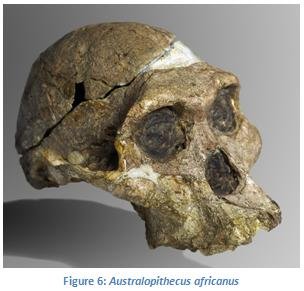
Although various classifications have been used, the australopithecines of South Africa can be classified into one genus Australopithecus, which includes at least two species consisting of the gracile Australopithecus africanus (southern ape of Africa) and the later robust type, Australopithecus robustus, which became extinct.
The first kind of an australopithecine was the remarkably preserved fossil skull of a young, ape-like creature embedded in limestone from a quarry site at Taung, northern Cape (Southern Africa), by Raymond Dart in 1924. Dart firmly believed that these hominins were ancestral to modern humans and named the Taung child Australopithecus africanus or southern Ape of Africa.Robert Broom subsequently uncovered the fossil skull of an adult version of Dart's find at Sterkfontein, Gauteng (Southern Africa).
This finally confirmed to the scientific world, that this creature was not an extinct species of ape, but a bipedal hominin with human-like dentition and a small brain.
In his excavations at Swartkrans and Kromdraai, Broom also found fossils of more robust version, which became known as Australopithecus robustus. Some of the researches, however, prefer the use of Paranthropus robustus for the robust specimens. Many australopithecine fossils have subsequently been found in East Africa. The suggestion that the East African Australopithecus afarensis may be ancestral to all the Australopithecinae, including those from Southern Africa and also to Homo, is not yet generally accepted. The fossilised footprints of a group of australopithecines, dated to more than million years ago, found at Laetoli, Tanzania, clearly show that these hominins habitually walked on two feet. At least two sets of parallel footprints, one set smaller than the other, were made in soft, damp volcanic ash which was subsequently covered by another ash fall (and which preserved those remarkable tracks).

At about 2 mya a spilt in the line of evolution led to the development in South Africa of a robust form Australopithecus robustus, which became extinct at about 1.5 -1 mya.

In East Africa Australopithecus boisei represents the robust line. The line that did succeed led to the origin of the genus Homo, represented by Homo habilis and Homo erectus. The relationship between robustus and africanus and their relationship with other early hominins and modern humans is complicated. Most of the Australopithecinae material from South Africa has been recovered from limestone caves which were formed underground by the action of water in the Dolomite Series of Transvaai Supergroup.
The bones of many animals accumulated in these underground caverns, because the bones fell through sinkholes connected to the surface. These early hominins were probably the victims of large carnivores who cached them in trees above the sinkholes and in the dark caves.
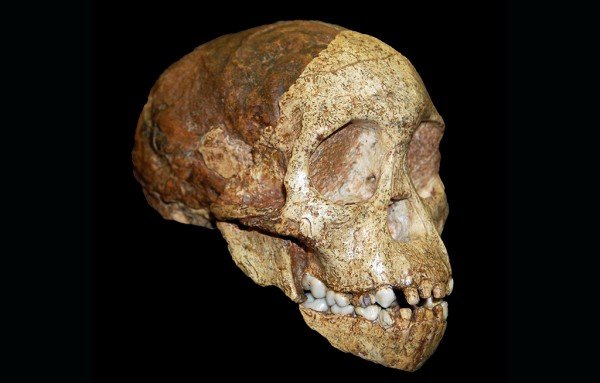
The Taung skull originated from bone-rich soil which collected in cavities in tufa deposits. The tufa was originally formed by the deposition of lime from spring waters issuing from dolomite rocks. Mats of algae growing in the waters precipitated the lime.
In acknowledgement of its importance, the area known as "The Cradle of Humankind" has now been awarded World Heritage status. This area includes all the sites already explored for hominins and other fossils, such as Sterkfontein, Swartkrans, Kromdraai, Gondolin, Plover's Lake, Wonder Cave, Drimolen, Haasgat, Coopers B, Gladysvale and Bolt's Farm.
Homo habilis and Homo erectus
The transition to Homo is marked by:
~ the progressive enlargement of the brain
~ dental changes (ie: development of smaller teeth)
~ more effective bipedal locomotion
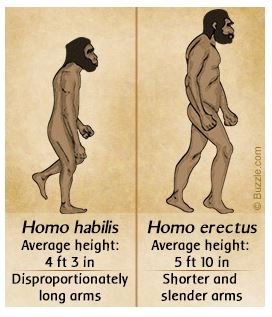
Current research indicates that stone tools appear at approximately the same time that the major anatomical changes became apparent. Evidence of tool making is regarded as important in the emergence of humanity, although the use of stone and other tools by primates for obtaining simple food and other purposes is well documented. Two early forms of the genus Homo, that is, Homo habilis and Homo Erectus.
The name Homo habilis literally means "handy man", which suggests the possibility that this hominin was the first to have been able to make tools. Homo habilis was resposible for the Oldowan stone tool industry (discussed in the next post). The most typical tools of this industry is the chopper.
In Southern Africa specimens of Homo habilis have been discovered at Swartkrans and at the Sterkfontein Exention Site near Krugersdrop in Gauteng. In addition to the finds from Olduval Gorge in Tanzania, habiline remains have also been discovered at Lake Turkana in Northern Kenya and at Omo in south of Etophia. Some researchers classify the individuals with large brains and large faces as Homo rudolfensis, whereas those specimens with small brains and small faces are labelled Homo habilis. No habiline remains have been recovered from Asia.
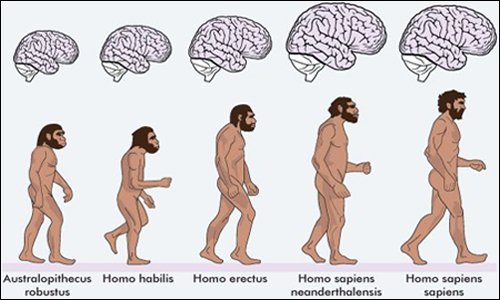
Homo habilis fossils show such diversity that there is growing consensus that more than one species of early Homo could have existed. Given the enormous variations found within the species, it is therefore convenient to refer to all these fossils as "early Homo". There is also a time overlap between habilis and erectus and, because it is sometimes difficult to assign fragmentary specimens to a particular genus, it is possible that some of these early Homo fossils could be erectus. It has been suggested that Homo habilis evolved from the earlier gracile australopithecines (afarensis and africanus) and that habilis later developed into Homo erectus, possibly as early as 1.6 million years ago.
The most obvious changes are in the brain case, the face and teeth and the lower limbs and other related post-cranial skeletal developments. A significantly larger endocranial volume may also mean corresponding greater complexity in the brain. More narrow and somewhat smaller molars are interpreted as indications of the increasing use of tools to replace some of the functional uses of teeth (eg: crushing and grinding). The derived features of the foot such as well developed arches and changes in the big toe for stability and shock absorption indicate habitual two-legged movement on the ground. (The term derived relates to a character state that reflects a more specific evolutionary line, that is, one that is not present in the common ancestor of a group and therefore diagnostic for the specific group . The hand bones of habilis were more curved than those of modern humans, but the thumbs was opposable for grasping purposes and the manipulation of fine objects. Larger brains and more dexterous hands probably encouraged the increasing use of tools as well as innovations and refinement in the production of tools.
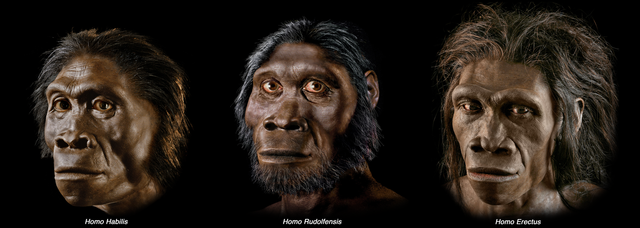
The Acheuline complex (will be discussed in the next post) is usually associated with Homo erectus. The transition to Homo erectus occurred during the early Pliestocene, when there is evidence that the australopithecines and Homo habilis both disappeared. The name Homo erectus is given to a widespread species of humans who are regarded as being the directancestral line to Homo sapiens. Homo erectus eventually extended their habitat beyond the African boundaries. A more extensive range of stone tool types is found in association with erectus, and there are indications that this hominin was a more successful hunter-gatherer and had a more complex social organisation than their evolutionary predecessors. Their technology was, however, remarkably uniform over space and time.
It is significant that Homo erectus represents the first hominins of which fossils have been found in areas other than Africa. Homo erectus hominins probably originated in East Africa and migrated to other regions and continents. The dispersal of Homo erectus populations from Africa is attributed to changes in climate, topography, water boundaries and access to food and other resources during the Pliestocene. These hominins inhabited a large part of the world over a period of approximately 1.5 million years, which indicates successful adaptation to a variety of environments.
Homo erectus exhibits an even larger brain than Homo habilis, and there are changes in the shape of the cranium, changes in facial structure (including smaller jaws and teeth) cranial buttressing, a taller stature and a more robust build. Their teeth, in particular, resembled those of modern humans. For example, enlarged pulp cavities and high tooth-crowns. As a result, the teeth could sustain more wear, an advantage if some hard chewing had to be done. An increased trend towards reduction of the back teeth and jaw muscles can possibly be ascribed to the use of tools for more extensive food processing including pounding and cutting, whereas large teeth and large jaw muscles were formerly essential for the crushing and grinding of food. The use of fire in the preparation of food may also have encouraged such changes.
The larger skull was also more robust and the bones of the brain case were very thick. This does not represent a primitive trend, but a derived feature - because the more heavy skull is accompanied by a reduction in the size of the jaw. The much larger overall body size of this hominin probably accounted, to some extent, for a significantly larger skull. The post-cranial bones, in particular the forward curving upper pelvis, a long slender femur and the relatively long lower limbs are essentially modern. The limb-bones are, however, thick-walled with strong muscle attachments.This suggests that Homo erectus led an active life, being continually on the move or covering long distances on their daily and seasonal rounds in search of plant and animal foods.
Homo Sapiens (archaic or Early sapiens)
Archaic Homo sapiens specimens have various identifying features and their average cranial capacity exceeds that of Homo erectus. Early archaic Homo sapiens specimens in Africa were found at Elandsfontein in the Western Cape (South Africa) , Kabwe in Zambia (130 000 years ago or older), Lake Ndutu near Olduvai in Zambia and Bodo in the Afar region of Ethiopia (600 000 years ago). Late archaic Homo sapiens is represented by specimens from North and East Africa, the Cave of Hearths in the Makapan Valley, the Limpopo Province, and Florisbad, north of Bloemfontein, Free State (South Africa).
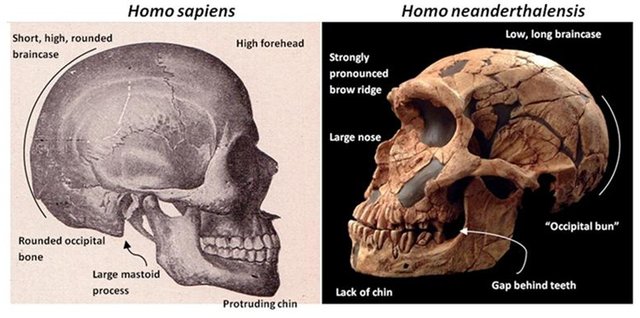
There are no Neanderthals in Africa, nor were there any in Far East. The term Homo sapiens neanderthalensis is restricted to Europe and Asia. Neanderthals were present in Europe and Asia about 125 000 years ago and disappeared approximately 40 000 to 30 000 years ago.
Thank you for reading
References: Deacon & Deacon (1999:64)
Jolly & White (1995:458)
Jurmain (2000:485)
Please Follow me for more on Archaeology and History.
Please check out my other posts:
Methods of absolute (direct and chronometric) age determination : Part 1 - Radiocarbon or 14C Method
Methods of Relative (Indirect) Age Determination used in Archaeology : Part 3
Methods of Relative (Indirect) Age Determination used in Archaeology : Part 2
Methods of Relative (Indirect) Age Determination used in Archaeology : Part 1 - Introduction
The Preservation of an Archaeological Site : Part 2
The Preservation of an Archaeological Site : Part 1
Discovering your own Archaeological Site : Part 3
Discovering your own Archaeological Site : Part 2
Discovering your own Archaeological Site : Part 1
Archaeological Sealed Sites and River Deposits : Is it an Archaeological Site or Not? - Part 3
Caves, Rock Shelters and Larger Open-Air Sites : Is it an Archaeological Site or Not? - Part 2
Is it an Archaeological Site or Not? - Part 1
Understanding the Archaeological Record : The Aims and Subject Matter of Archaeology - Part 2
The Aims and Subject Matter of Archaeology - Part 1
Archaeology and the Natural Sciences
Introduction to Ethnographic Analogy and Ethnoarchaeology
The Nature and Scope of Archaeology
The Three - Age System : The Stone Age, The Bronze Age and The Iron Age
The Roots of Modern Archaeology
Significant 18th and 19th Centuries Discoveries in Archaeology
Archaeology as a Profession- Part 2
Archaeology as a Profession- Part 1
To Become or Not Become an Archaeologist? - Introduction to Archaeology Part 2
Please Upvote and Resteem.
Thank You!
What an incredibily well put toghether post! Well, for me this is a lesson 🙂 Considering the sheer amount of information in it...
Thank you for sharing all this with us @zest! Beautiful job!
Your words are truly heartfelt @abigail-dantes, I am grateful to you for taking the time to read my post and enjoy it, knowing that my post has been informative, I feel is the greatest reward. Thank you my dear friend!!!!
:)
That's a great post, as always. I have no question this time. :)
Hi @lemouth, for me it's an honor to have you read and enjoy my posts. Thank you sincerely my dear friend!!!!!!
Great info, Indy. I'm going to check out your other posts. Followed.
Hi @cryptastic, Thank you so much for the support, comment and following me, I am truly grateful. If you like you can join us at the SteemSTEM chat room on Steemit Chat. Thank you once again.
Cool, I'll do that, thanks
As always a great post. I have always been interested in Paleontology, I spent a part of my early adulthood exploring caves in the sterkfontein area, long before it became "The cradle of Humankind". We had no idea what was around us, although we were aware of the work being done and the fossils being discovered in the area.
Holy information, @zest! I envy Archaeologists, for they get to discover all of the really fun stuff. I learned more in 1 post than I did in an entire semester of Ancient History. (we only touched on the originals briefly.) Thank you for sharing and for your upvote on my story. You have got yourself an upvote and a new follower. I love to learn and it appears that you love to share information ;)
See ya next time!
Mo
This post has received a 3.04 % upvote from @buildawhale thanks to: @trumpman. Send 0.100 or more SBD to @buildawhale with a post link in the memo field to bid on the next vote.
To support our curation initiative, please vote on my owner, @themarkymark, as a Steem Witness
@trumpman yet again you totally Rock!!!!!
Thank you buddy!!!!!
stop thanking me. I like your posts, a small tip is nothing!
This post has received a 0.78 % upvote from @drotto thanks to: @banjo.
Well then it wasn't very robust, was it? Hopefully our self-made climate change won't prove too catastrophic and make our "wise wise" epithet the butt of some future species' joke!
I think it might be the other way around. Nature selected use of tools (because it was beneficial for survival), and use of tools was associated with (caused by?) larger brains, so the brains got dragged along.